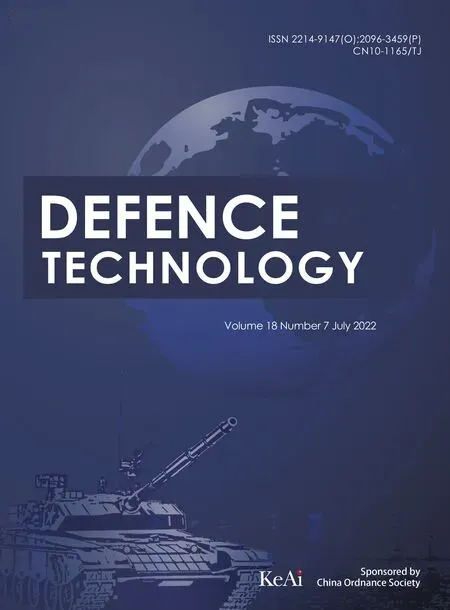Close-in weapon system planning based on multi-living agent theory
Tang Tang, Yue Wang, Li-juan Jia, Jin Hu, Cheng Ma
School of Information and Electronic, Beijing Institute of Technology, Beijing,100081, China
Keywords:Multi-living agent theory Close-in weapon system Effectiveness evaluation Livelihood degree Queueing system Missile-gun integrated weapon system
ABSTRACT The close-in weapon system(CIWS)is a combat system that faces a complex environment full of dynamic and unknown challenges, whose construction and planning require a systematic design method. Multiliving agent (MLA) theory is a methodology for the combat system design, which uses the livelihood degree to evaluate the multi-dimensional long-term operational effectiveness of the system; whereas,there is still no uniform quantization framework for the livelihood degree,and the adjustment methods of livelihood degree need to be further improved. In this paper, we propose the uniform quantization framework for the livelihood degree and detailed discuss the methods of livelihood adjustment.Based on the MLA theory, the multi-dimensional operational effectiveness of the missile-gun integrated weapon system (MGIWS) is analyzed, and the long-term combat effectiveness against the saturation attack is assessed. Furthermore, the planning problem of the equipment deployment and configuration is investigated. Two objectives, including the overall livelihood degree and cost-effectiveness (CE), are proposed, and the optimization method based on genetic algorithm (GA) is studied for the planning problem.
1. Introduction
In modern warfare,high-tech equipment has been put into use,which has gradually changed the form of war into joint operations based on information systems.Combat effectiveness is frequently a topic of significant interest in military combat operations. The methods of assessing equipment’s effectiveness are mainly based on the concept of the effectiveness index to represent the effect of weapons on a wide variety of targets[1].Currently,there are many combat effectiveness evaluation methods for specific equipment or systems, such as detection equipment [2-4], strike equipment[5-7], communication system [8-10], and so on. However, it is difficult to configure and deploy the system only depending on the effectiveness indices of single equipment or system to enable the system to carry out combat tasks efficiently and reliably in a complex and dynamic operational environment. In order to meet the combat requirements in a specific operational scenario, it is necessary to conduct a systematic effectiveness evaluation for the system in a specific environment. At present, there are some categories for evaluating system combat effectiveness, including expert evaluation [11], analytical methods [12-14] and combat simulation methods [15-18].
A close-in weapon system (CIWS) is a point-defense combat system to detect and destroy short-range incoming missile and enemy aircraft which have penetrated the outer defenses [19].There are some researches that study the combat effectiveness of CIWS.Yang et al.[20]analyzed the combat effectiveness of airborne tactical ballistical anti-ship missile against the CIWS,which mainly focused on the relation between the speed of missile and the penetration capability. Zhang et al. [21] used Monte Carlo simulation to analyze the interception effectiveness of CIWS on different prototypes of hypersonic missile(HM)and explored the feasibility of using CIWS to intercept HM and the improvement measures. In the context of distributed combat[22],saturation attack formed by a large number of unmanned aerial vehicles (UAVs) with strike capability might be a major challenge for the CIWS, which has the advantages of strong autonomy,low price,high degree of freedom and rapid upgrade[23].Considering the interception effectiveness against the saturation attack,queueing theory can be used to model the combat process of CIWS.Liu et al.[24]synthetically researched the calculating problem about the penetration probability of antiship missile with the queueing theory under the condition that surface ships formation adopt various means to help to oppugn mutually.Zheng et al.[25]analyzed the penetration effectiveness of anti-ship missile and stealth airplane to the “Phalanx” system and the influence of flying parameter of aircraft. Zhao et al. [26]calculated the combat effectiveness of the “Sidewinder” and “Tor-M1” defense missile weapon system with the queueing theory.Previous effectiveness evaluations of CIWS against the saturation attack mostly used the single-layer queuing model to analyze the interception probability of surface-to-air missile (SAM) or antiaircraft gun (AAG) systems, rather than that of the missile-gun integrated weapon system (MGIWS), which should be further explored.Besides,the studies did not take the states and reliability of the system under long-term combat situation into consideration,which is also important effectiveness should be considered in the combat. For example, in the Gulf War, ”Patriot” failed to intercept the”Scud”missile because of the failure caused by the long hours of continuous operation [27].
For the design and planning of the combat system under the strongly constrained and hostile environment, Wang [28,29] proposed the Multi-living agent (MLA) system theory. Livelihood degree was studied to evaluate the multi-dimensional continuous effectiveness of the system.It is a new method for research,design,and analysis of a combat system. MLA method was established based on the dissipative self-organization theory, and the humandominated heter-organization was emphasized to maintain the effectiveness of the system[30].Based on the MLA system theory,a series of studies have been carried out.Wang et al.[31]studied the distributed intrusion detection system based on MLA with the queueing theory. It was shown that the security and reliability of the proposed system are effectively enhanced, and the agent can normally work in a strongly constrained and hostile environment.Liu et al.[32]proposed an analytic hierarchy process based method with a dependent pairwise comparison matrix for the evaluation of the livelihood degree of the MLA system. An application to the netted radar system was illustrated to support the proposed method. Tang et al. [33] put forward the overall design method of the high-performance artificial system based on MLA, which took the functional livelihood degree as the basis for research and development. Zhao et al. [34] studied the architecture adjustment method based on MLA theory. By replacing the principal-agent or adding a new living agent, the system architecture is adjusted to maintain the system’s functional livelihood to meet the task requirements. Although many studies have been proposed on the MLA theory, there is still no uniform standard for the quantitative characterization of the livelihood degree. The mechanism of livelihood adjustment needs to be summarized and explained.
In this paper, we propose a unified framework for the assessment of the livelihood degree and discuss the methods for adjusting livelihood. On this basis, we use the two-layer queuing model to evaluate the interception probabilities of a CIWS consists of multiple joint operated MGIWSs. Considering the equipment failure and maintenance, we further analyze the long-term operational livelihood degree in different configuration strategies. In a multi-point deployment scenario, we propose two objectives to plan different configuration schemes: combat effectiveness preferred and cost-effectiveness (CE) preferred. The optimization method based on the genetic algorithm (GA) is proposed to solve the planning problem.
The rest of this paper is arranged as follows: In Section 2, the uniform quantization framework for the livelihood degree and the adjustment methods of livelihood degree are proposed. In Section 3, we propose the long-term operational livelihood degree assessment method of MGIWS under different configuration strategies. In Section 4, for the planning of the battlefield equipment deployment and configuration, we propose two strategies with different optimization objectives and use GA to solve them. In Section 5,numerous simulations are carried out to show the result of the proposed method. The conclusion in Section 6 presents the main innovation of the proposed method and some further work.
2. MLA system theory
2.1. The define of living agent and livelihood degree
In the define of MLA, the term”agent”derives from the field of computer software design, which indicates an autonomous entity that carries out tasks on behalf of users. ”Livelihood” means the ability to maintain specific service functions. The ”living agent”combines the human intentions and the structure of systems in terms of livelihood to achieve a particular functional purpose. The being of a”living agent”is reflected in its continuous effectiveness in the system. The being has two forms: the tangible form of the structure which is constructed by hardware and software, and the intangible form which is composed of man’s related concepts and the mutual relations they formed. The livelihood can be quantitatively characterized by the livelihood degree F [30], that is, the possibility to complete a specified task.
According to Ref. [29], the six-element relationship group of a living agent is shown as follows to characterize the dynamic characteristics:
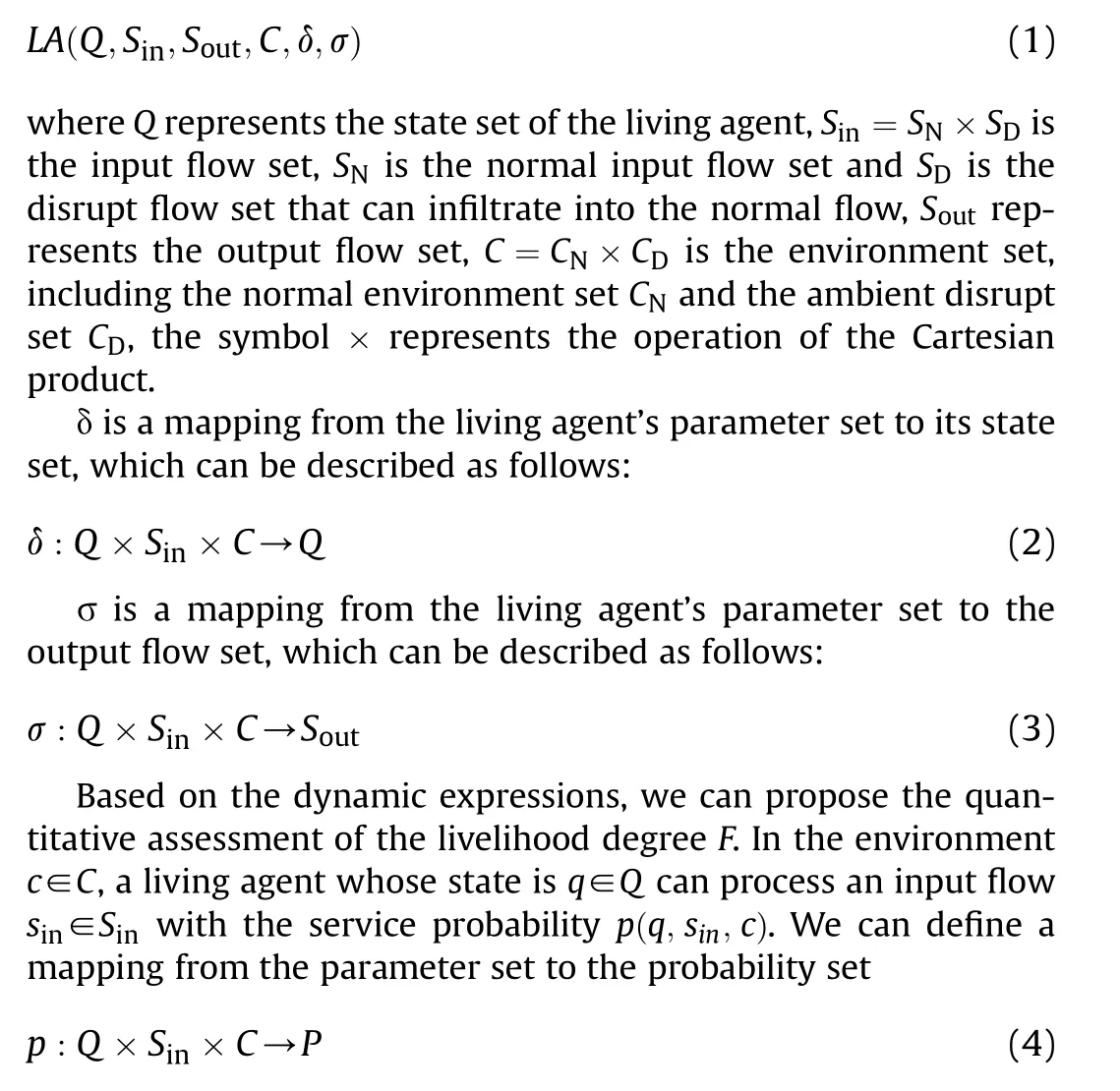
where P represents the set of service probability in all the possible cases.The MLA theory was proposed to design and analyze systems in a complex and hostile environment.Therefore,in the evaluation of livelihood degree,the service probability in the ideal state is not appropriate to be used as an evaluation standard, because the antagonistic factors might be designed to counter the weakness of the system. Thus, we use the long-term service probability in the rigorous case to evaluate the livelihood degree.
2.2. The structure of MLA system
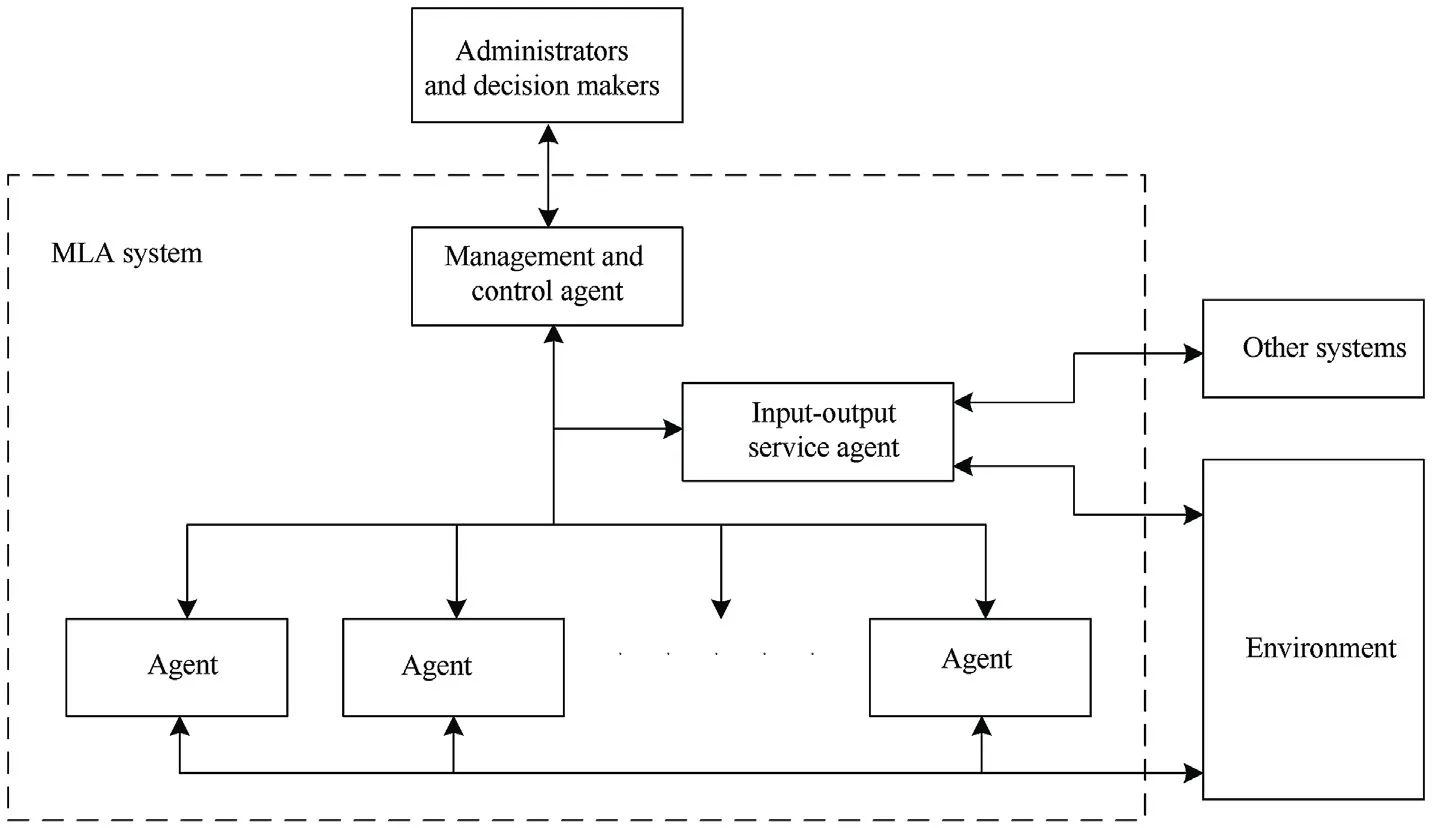
Fig.1. The structure of the MLA system.
The structure of the MLA system is shown in Fig.1. In order to meet the real-time scheduling requirements of the system, the living agents should have a unified interface and should be universal and tailorable to support efficient resource interaction and collaboration. The MLA system consists of three layers, where the underlying layer consists of the multiple functional living agents,the middle layer is the input and output interface layer,and the high layer is the management layer backstage.The living agents at the underlying layer perform perception, processing, state adjustment and output control tasks according to the selforganizing mechanism of the system. Living agents cooperate through interactions to achieve overall requirements. The inputoutput agent is responsible for the interaction between the MLA system and other systems and environment, including the input and output of information, substances, and energy. The management and control (MC) agent is responsible for MLA’s information collection, information processing, and overall control.
In the case that the self-organization mechanism of the system is able to meet the functional requirement, the MC agent is responsible for the negotiation and coordination among the living agents in the system, which is based on the logic and the expert systems. When the self-organization mechanism of the system cannot meet the functional requirements, the heter-organization should be implemented under the guidance of humans, such as adjusting the system decision-making strategy,adding or replacing agents, modifying the system architecture. In a complex environment full of strong constraint and confrontation, to meet the dynamic and complex demands, the MLA system should be able to maintain and adjust the living agents through the self-organization of the MC agent and the high-level heter-organization.
2.3. The livelihood adjustment methods
As shown in Fig.2,there are two levels for the adjustment of an MLA system:agent level adjustment and system level adjustment.
2.3.1. Agent level adjustment
When a weak link occurs and leads to the decline of the overall performance,the agent level adjustment is often first considered to maintain the overall livelihood of the system.
Replacing agent is the most straightforward approach to make up for the weak link;however,this method has a high requirement on the capability of the new agent, which might be difficult to achieve due to technical constraints.
Except for replacing the agent directly, we can consider adding agents to improve the livelihood. The advantage of adding living agents is that it can satisfy the service requirement by a combination of agents available, while the disadvantage is that it increases the cost and the redundancy of the system.The following types of agent can be added to improve the livelihood of the original agent.
(1) Serial agent: When a type of task can be accomplished step by step and the original agent can only achieve one of the steps, a serial agent can be added to pre-process or postprocess the task. The service probability of this link is the probability that both the two agents operate successfully.
(2) Homogeneous parallel agent:When a weak link is due to the high task intensity or low service probability and the original agent has no function dimension loss,a homogeneous agent can be paralleled to increase livelihood. This link is failed only if all the agents failed to provide service.
(3) Heterogeneous parallel agent: When there is a defect that occurs in the original agent’s function dimensions due to the change of environment or requirement, we can consider adding a heterogeneous parallel agent with complementary function dimensions to enhance the livelihood.
(4) Livelihood maintenance agent: When an agent will be degraded or broken due to long-term work, a livelihood maintenance agent can be added to monitor and maintain the state of the agent.This method is effective in maintaining the long-term effectiveness of the agent.
2.3.2. System level adjustment
In the case that the inadequacy of system livelihood is not caused by a single agent, the system-level adjustment should be considered.
If the system could not meet the new requirements under the previous system architecture, the method of architecture adjustment can be adopted. By reconfiguring the system structure,operation processes,coordination strategies to enable the system to fulfill the task requirements in the target environment.
In the case that the system architecture can meet the requirements,but the livelihood is difficult to reach the optimum due to the changeable environment and tasks, a variety of operational modes can be set up to realize the switching between modes based on the dynamic perception and evaluation of the environment and tasks.

Fig. 2. The livelihood adjustment methods.
In the next section, the livelihood degree and the adjustment methods of CIWS are investigated on the proposed method.
3. Livelihood degree assessment of CIWS
3.1. Background and architecture of the CIWS
The mission of CIWS is to defend the important strategic location, which is the last line of defense to intercept enemy attacks.The target types are various aircraft and air-to-surface missiles(ASMs). In the case that the enemy adopts a full range of multibatch intensive attack, CIWS needs to perceive the dynamic information and situation of the enemy’s intrusion flow in time and coordinate the subsystems to carry out the effective interception.
The main requirements of the system can be divided into several sub-requirements, including searching, tracking, destroying the target, computing support, commanding and controlling, humancomputer interaction. The sub-requirements can be achieved through corresponding functional agents and the system architecture is shown in Fig. 3.
The searching agent is composed of the searching radars,which searches for the aircraft within the detection range and reports target information to the subsequent agents.
The tracking agent is responsible for continuously tracking after the searching agent detects the target. It complements the effectiveness dimension of radar and optical equipment through the heterogeneous parallel livelihood adjustment method. The radar has a strong ability to track moving targets and is less affected by visibility. Optical detection equipment has the advantages of high concealment, strong passive detection ability and strong tracking ability to the extremely slow-moving and static targets.Besides,the optical equipment has the imaging ability,which makes up for the shortcomings of the radar in target identification and greatly improves the reconnaissance and monitoring effects.
The firing agent receives the firing command of the MC agent and strikes the enemy’s invading targets.This system considers the parallel architecture of SAM and AAG,which is regarded as MGIWS.AAG has the advantages of high initial velocity, high rate of fire,high close-range hit accuracy, high probability of damage, short response time,strong anti-interference ability and low combat cost,which is responsible for the super-close-range interception mission. SAM has a high single-shot kill probability and a large strike range, and the kill probability is basically unchanged within the range.It can be responsible for the interception mission outside the range of AAG. As the strike range shown in Fig. 4, through the heterogeneous parallel livelihood adjustment method of the SAM agent and AAG agent,the combat effectiveness of the firing agent in the space dimension can be supplemented.

Fig. 3. The architecture of CIWS.
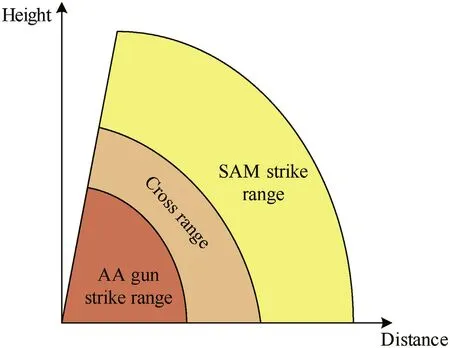
Fig. 4. The strike range of MGIWS.
The computing agent and the MC agent are responsible for the collection, processing and distribution of information in the system. They support the commander’s unified management and control of the system.
Considering the high effectiveness requirement of CIWS, multiple MGIWSs can be combined for joint operation,which enhances the livelihood degree through the homogeneous parallel method.
3.2. Interception probability assessment
For the CIWS described in Section 3.1, the interception probability can be evaluated as p(q,s,c), where sis the input information of the enemy’s targets that might be mixed with interference,c is the combat environment of CIWS,q is the operation state of CIWS. Besides, sis the interception flow output by the system. The prerequisite for the successful destruction of the target is that each functional sub-agent of CIWS successfully completes the task. Therefore, considering the process of the interception mission, the interception probability is
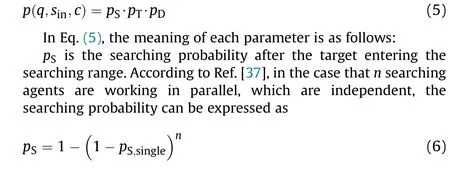
where pis the searching probability of a single searching radar.
pis the probability that the system successfully track the detected target and meet the fire control command requirements.
pis the probability that one of the SAM or AAG strike and destroy the tracked target, that is,

pis the probability that the SAM agent fires and destroys the target in the SAM strike range,that is,

where pis the probability that AAG agent can fire at a tracked target that enters the strike range of AAG agent,and pis the kill probability of a round of AAG fire.
Among the above parameters, most of them can be calculated according to the equipment parameters; whereas, the fire probabilities of SAM and AAG need to be evaluated combining with the specific attack flow intensity and the number of parallel systems.In section 3.3, the destruction probability is evaluated with the queueing model.
3.3. Evaluation of the destruction probability
Due to the uncertainty of military confrontation, we consider the situation that we cannot predict the follow-up situation based on the current situation and take corresponding countermeasures.Therefore, a model without aftereffect is used to simulate the interception process of CIWS. Construct a two-layer impatient M/M/n queuing model as shown in Fig. 5 and make the following assumptions:
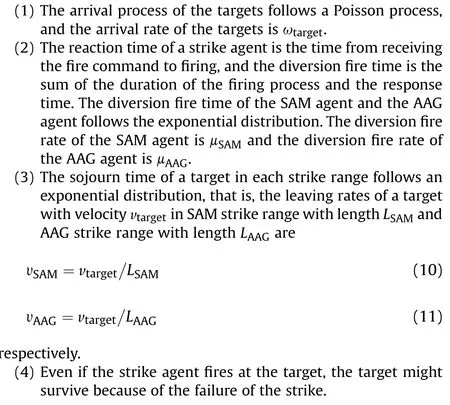
First,consider the first layer of the queuing model,which is the combat process of SAM. The arrival rate of targets is the rate that targets are detected and tracked, that is,

According to Ref.[33],with the arrival rate ω,the service rate μ,the leaving rate υ and the number of servers n, the service probability of the impatient M/M/n queueing model can be calculated as
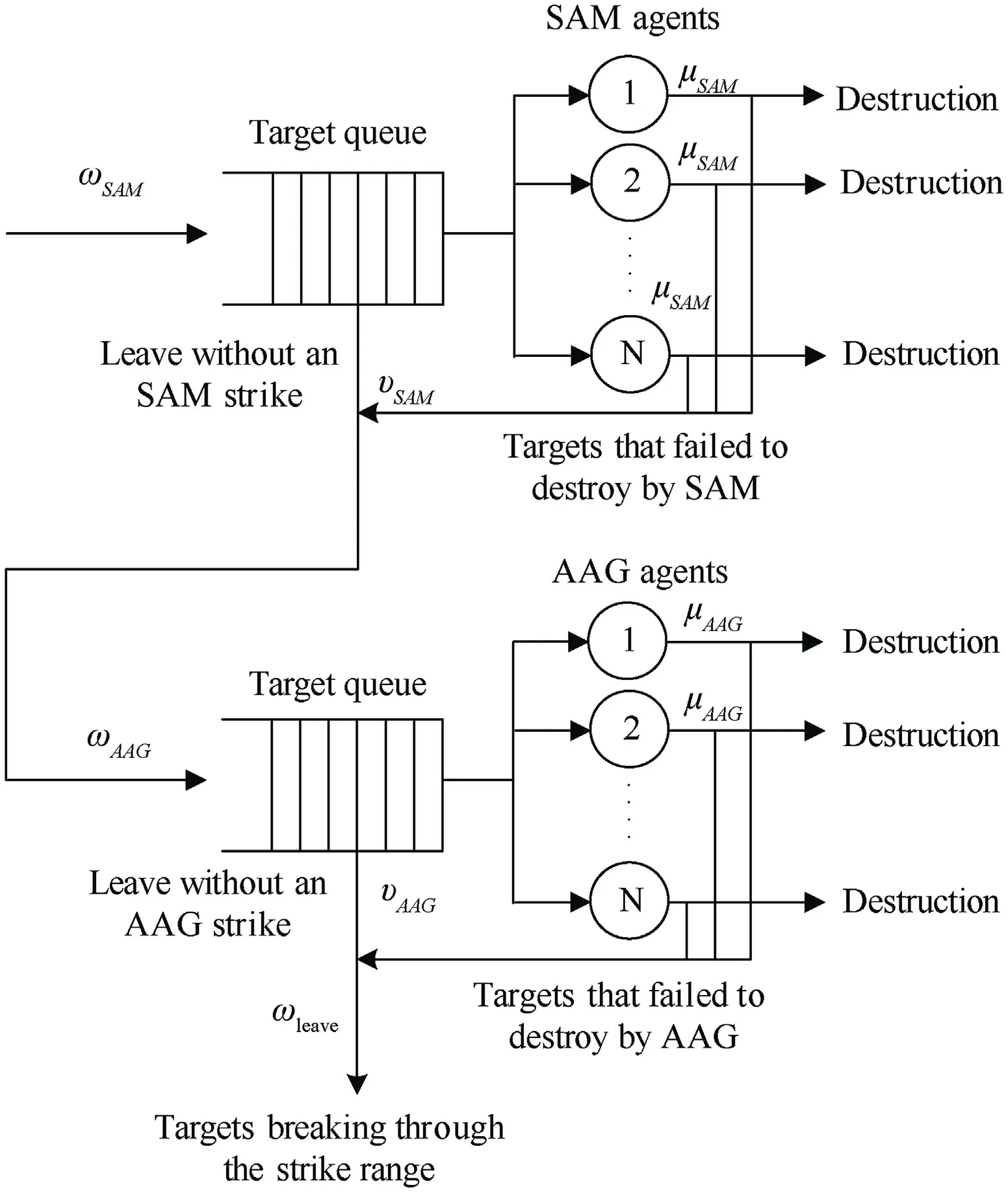
Fig. 5. The two-layer M/M/n queueing model.
Similarly, substituting the parameters ω, μ, υand n into Eq. (12), the fire probability of AAG can be obtained as p.
As the fire probabilities pand pcan be obtained, the destruction probability pcan be calculated according to Eqs.(7)-(9). Further, the interception probability can be obtained via Eq. (5).
3.4. Long-term livelihood degree assessment
The previous sections studied the interception probability p(q,s,c)of the joint operated MGIWSs in the face of the input sunder a specific environment c. To further consider the long-term operational livelihood degree of the system, it is also necessary to consider the change of the system state q,including the equipment failure and maintenance.Consider that the system consists of N sets of MGIWS for the strike and M sets of maintenance equipment for the maintenance,which adjusts the long-term livelihood degree of the system by means of adding livelihood maintenance agents.
3.5. Make the following assumptions
(1) Each operating MGIWS is subjected to deterioration over time, and the time to failure follows an exponential distribution with the failure rate η.
(2) Each maintenance equipment can repair an MGIWS in failure, and multiple maintenance systems cannot carry out coordinated maintenance on a single failed MGIWS. The maintenance time follows an exponential distribution with the maintenance rate γ.
(3) MGIWS can stay in the sleep state, that is, it does not participate in the combat missions and will not turns into a failure state.
Define qto represent the state of CIWS that there are n MGIWSs in normal state,where 0 ≤n ≤N,and the state set of the system is Q = {q,q,…,q,q}.
According to the principle of diminishing marginal utility [35],when the number of paralleled MGIWSs exceeds a certain number,more working agents might not be able to greatly improve combat effectiveness but increase unnecessary losses. We can consider an operational strategy to avoid the unnecessary wastage of the system during long-term combat.When the number of MGIWSs in the normal state is greater than K,where 1 ≤K ≤N,the extra MGIWSs can stay in the sleep state, and only K MGIWSs will participate in the combat missions.
Therefore, we can define two parameters to represent the numbers of operating MGIWSs and maintenance equipment at state qas in Eqs. (15) and (16), respectively.

Consequently, the forward Chapman-Kolmogorov (C-K) equations can be written as follows
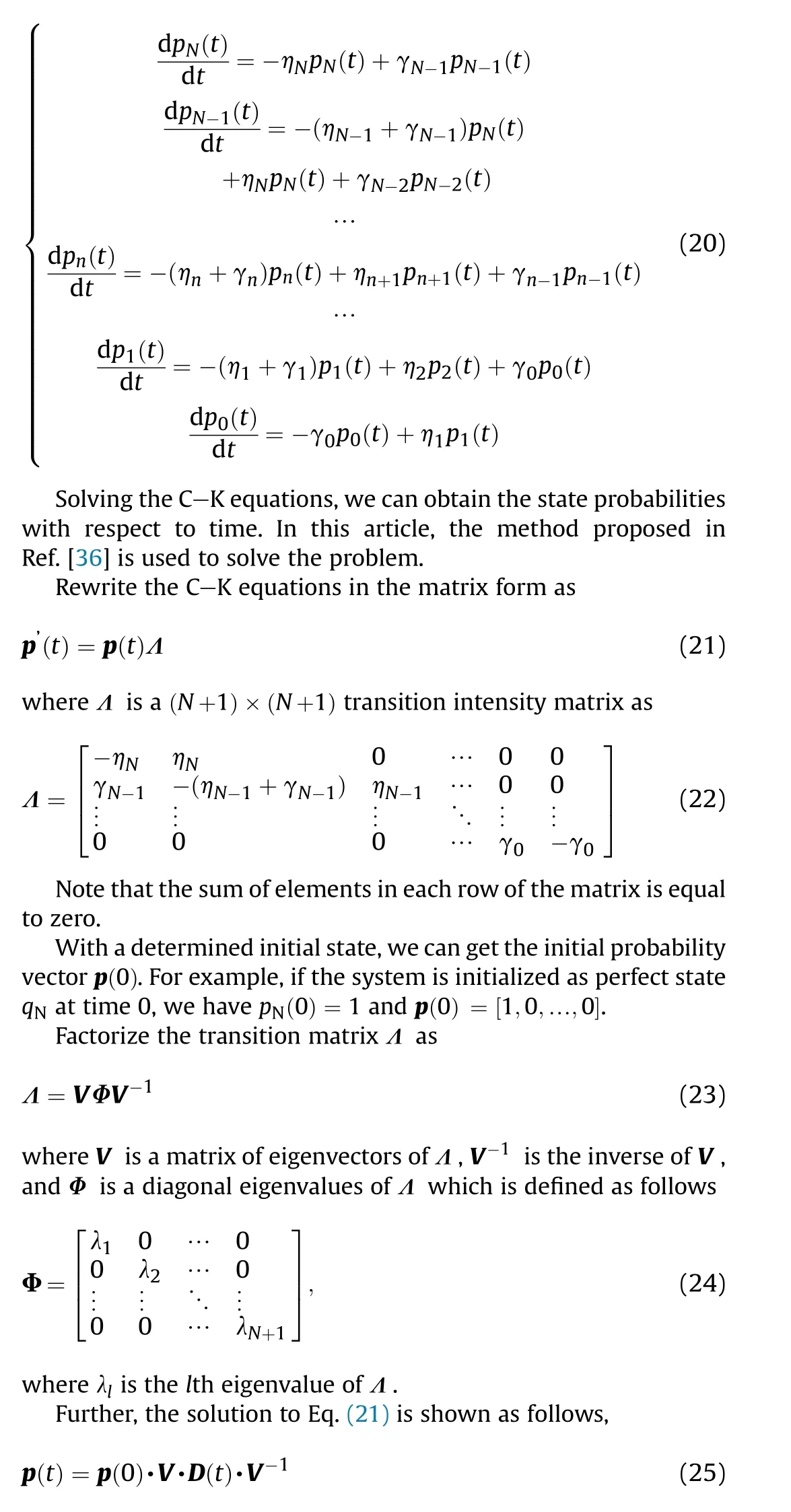
where

Fig. 6. Transition diagram of CIWS states.
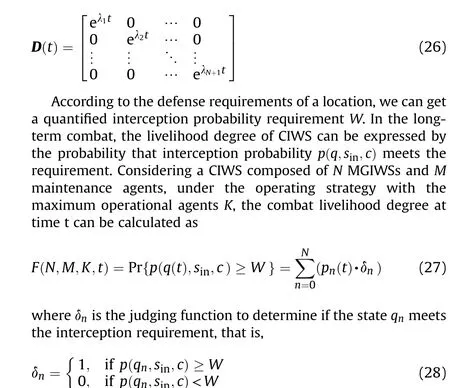
Furthermore, taking the limit of Eq. (27) as t→∞, the steadystate livelihood degree of CIWS can be obtained as F(N,M,K).
This section considers the long-term combat livelihood degree assessment method of a CIWS under a certain configuration strategy, and the next section will study the overall deployment and configuration strategy planning method of CIWSs on the battlefield.
4. Planning method of the deployment and configuration strategy
4.1. Planning problem description
On the battlefield,CIWSs are needed to be deployed at multiple strategic locations.With the limit of the amount of equipment,it is an important issue to optimize the overall combat effectiveness of the battlefield through the planning method. Assume that the numbers of MGIWSs and maintenance equipment that can be deployed on the battlefield are Nand M,respectively.CIWSs must be deployed at I strategic locations, and the CIWS at each location are independent of each other.
The strategic locations can be divided into G important grades.For the i-th strategic location,its importance grade is g?{1,2,…,G},the maximum target intensity is ω,the interception probability requirement is W, and the long-term livelihood degree requirement is D.
The purpose of the battlefield commander is to make the CIWS of each strategic location meet the interception requirement and optimize the overall combat effectiveness through rational equipment deployment and operational strategy planning under the constraint of equipment amount.In this study,we achieve the goal of overall optimization by adjusting the number of MGIWSs N,the number of maintenance equipment Mand the maximum operational number Kat each location.
Note that,we add a subscript i to a parameter to indicate that it belongs to the ith location.
4.2. Optimization objective
Differ from the general equipment deployment and configuration problems that mainly consider the overall performance of the system in the ideal state[38-40],the optimization objective of this planning problem is to optimize the long-term overall combat effectiveness. We propose two objectives to achieve this goal,including the weighted arithmetic mean of livelihood degree and the CE.
For the first case, we only consider the overall interception effectiveness and use the weighted sum function of interception effectiveness livelihood degree as the objective,which is shown as follows
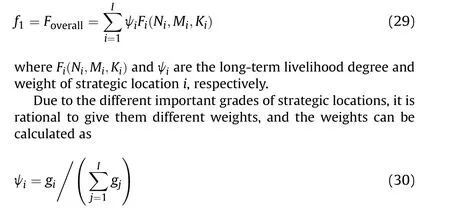
In addition to the combat effectiveness,the cost may also be an important dimension that needs to be considered in the decision.We can consider the overall combat CE as the objective rather than merely combat effectiveness.
Assume that the operating costs of the operating MGIWS and the maintenance equipment are cand c, respectively. The expected operation cost of location i is
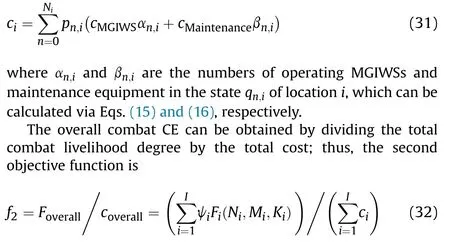
4.3. Solution to the planning problem
To plan the deployment and operation strategy to implement overall optimization, the planning problem is given by


Constraint(34)determines that the long-term livelihood of each CIWS should satisfy the livelihood degree requirement of each location. Constraints (35) and (36) indicate that the deployment must be executed with limited MGIWSs and maintenance equipment.Constraint(37)determines that the number of maintenance equipment should not exceed that of MGIWSs. The maximum operating number should be no more than the number of MGIWSs,which is expressed in constraint (38).
In this article,the planning problem is solved with GA,which is widely used in operations research to deal with combinatorial optimization problems and generate global high-quality solutions.GA has been demonstrated to converge to the optimal solution for many diverse difficult problems, although optimality cannot be guaranteed.
GA starts by randomly initializing a population of chromosomes in the first generation,and each chromosome represents a possible solution to the optimization problem.As shown in Fig.7,we express a chromosome as a row vector X. Each chromosome consists of 3I genes.The first I genes represent the numbers of MGIWSs deployed at different locations. The genes from Xto Xrepresent the numbers of deployed maintenance equipment,and the genes from Xto Xrepresent the maximum numbers of operating MGIWSs. The pseudocode of the proposed optimization algorithm is shown on the bottom of this page. The fitness function, i.e. the objective function in Eq.(29)or(32),is used to evaluate the quality of individuals. After calculating the fitness values of the chromosomes, existing individuals are recombined using cross-over, mutation and reproduction procedures,to obtain the next generation.GA terminates when a given number of generations Nis attained or the improvement of fitness value is not greater than a threshold ε.
5. Simulation and analysis
Several numerical simulations are conducted in this section to assess the performance of the proposed livelihood degree evaluation method and planning method.
Simulation 1. Consider a combat scenario where a CIWS composed of MGIWSs faces the saturation attack.The specifications of a type of MGIWS are shown in Table 1. Countering the invading targets with maximum speed 500 m/s,the interception probability of a CIWS consists of n operating MGIWSs can be calculated via Eq.(5),and the required parameters can be derived from the indicators in Table 1.
We assume that the SAM is responsible for interception tasks within the SAM strike range but outside the AAG strike range,and AAG fires after the target enters the AAG strike range.AAG fires at the target for 1 s each time, that is, 10 rounds per fire. Then the diversion fire rate of AAG is
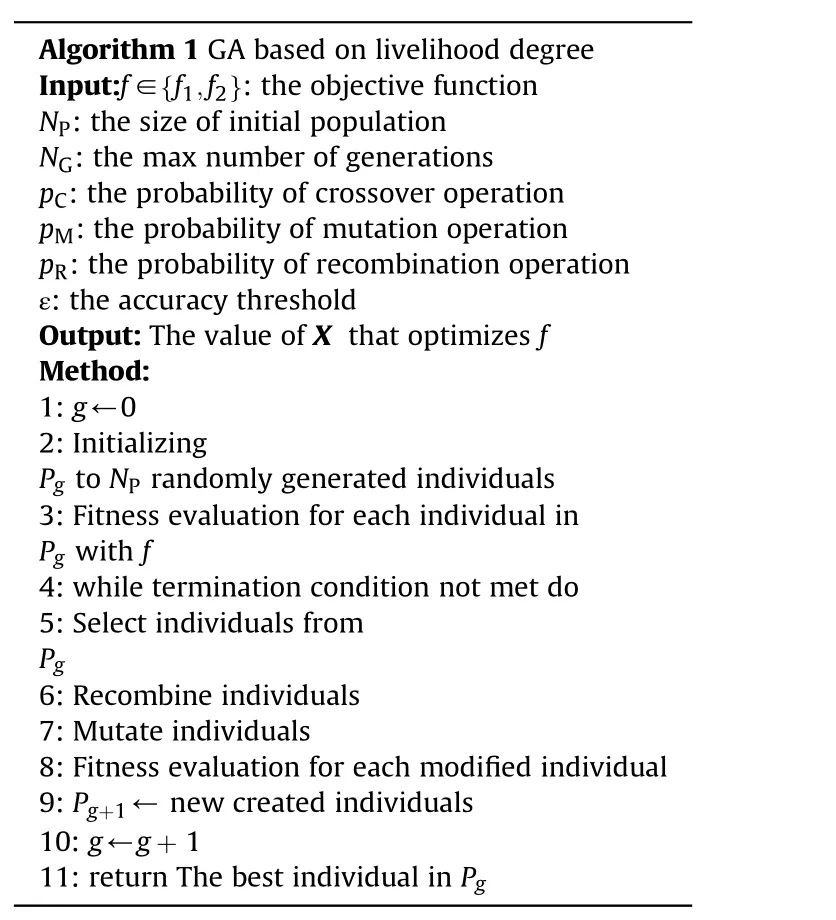
Algorithm 1 GA based on livelihood degree Input:f ?{f1,f2}: the objective function NP: the size of initial population NG: the max number of generations pC: the probability of crossover operation pM: the probability of mutation operation pR: the probability of recombination operation ε: the accuracy threshold Output: The value of X that optimizes f Method:1: g←0 2: Initializing Pg to NP randomly generated individuals 3: Fitness evaluation for each individual in Pg with f 4: while termination condition not met do 5: Select individuals from Pg 6: Recombine individuals 7: Mutate individuals 8: Fitness evaluation for each modified individual 9: Pg+1←new created individuals 10: g←g+ 1 11: return The best individual in Pg
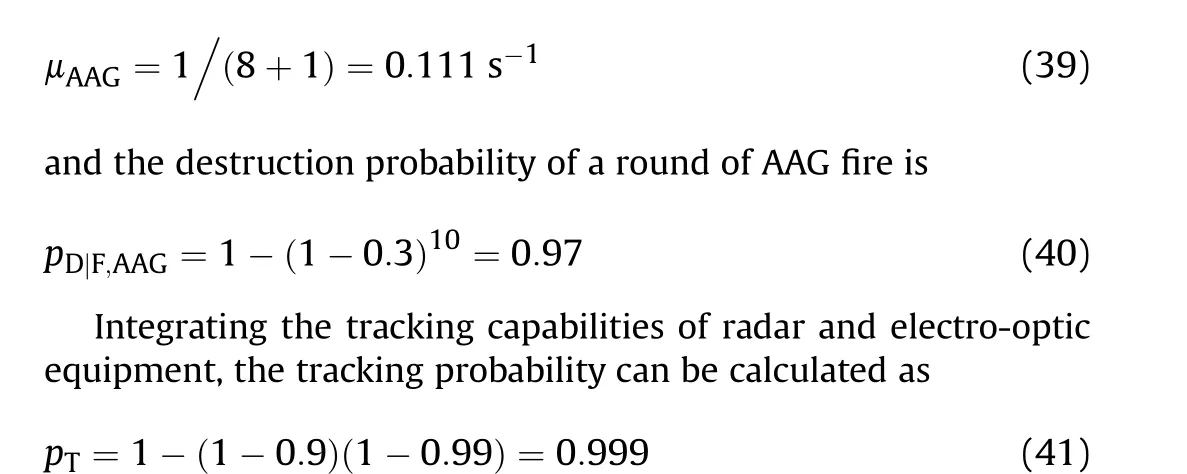
Based on the specifications in Table 1, the parameters required by the proposed model can be obtained as shown in Table 2.
According to the proposed 2-layer M/M/n queueing model in Section 3, the interception probabilities of CIWS consists of n operating MGIWSs against different target intensities ωcan be calculated via Eq. (5), and the results are shown in Table 3 on the top of the next page. On this basis, the curves of the interception probability in different conditions can be obtained as shown in Fig. 8.
It can be concluded that the increase of the intensity of the targets will result in a decrease in the fire probabilities of the firing agents and further reduce the interception probability of CIWS.Besides, the method of paralleling MGIWSs can be adopted to enhance the interception probability, which verifies the effectiveness of the homogeneous parallel livelihood adjustment method.

Fig. 7. Chromosome representation of GA.

Table 1 Specifications of an MGIWS.

Table 2 Parameters of the proposed model.
Simulation 2. On the basis of simulation 1, we consider the long-term interception mission livelihood degree of CIWS consists of the above-mentioned MGIWSs under different configuration strategies.
In the situation that the intensity of the intrusion targets is ω=0.3 and the interception requirement of CIWS is W =0.85,the livelihood degree of the CIWS consists of N MGIWS and M maintenance equipment,with the maximum number of operating agents K, can be calculated via Eq. (27).
There are numerous configuration strategies that can be adopted,and we choose the five strategies as shown in Table 4 to analyze the influence of different parameters on the livelihood degree.
The curves of the livelihood degree in different configuration strategies over time are shown in Fig. 9 and the steady-state livelihood degree are shown in Table 4. It can be inferred that the livelihood degree gradually decreases over time and finally convergences to the steady-state. In the initial stage, the livelihood decreased because the failure rate of MGIWSs is greater than the maintenance rate.With the failure of MGIWSs and the operation ofmaintenance equipment, the failure and maintenance of MGIWS gradually reach a dynamic balance, and the system also tends to a steady-state.
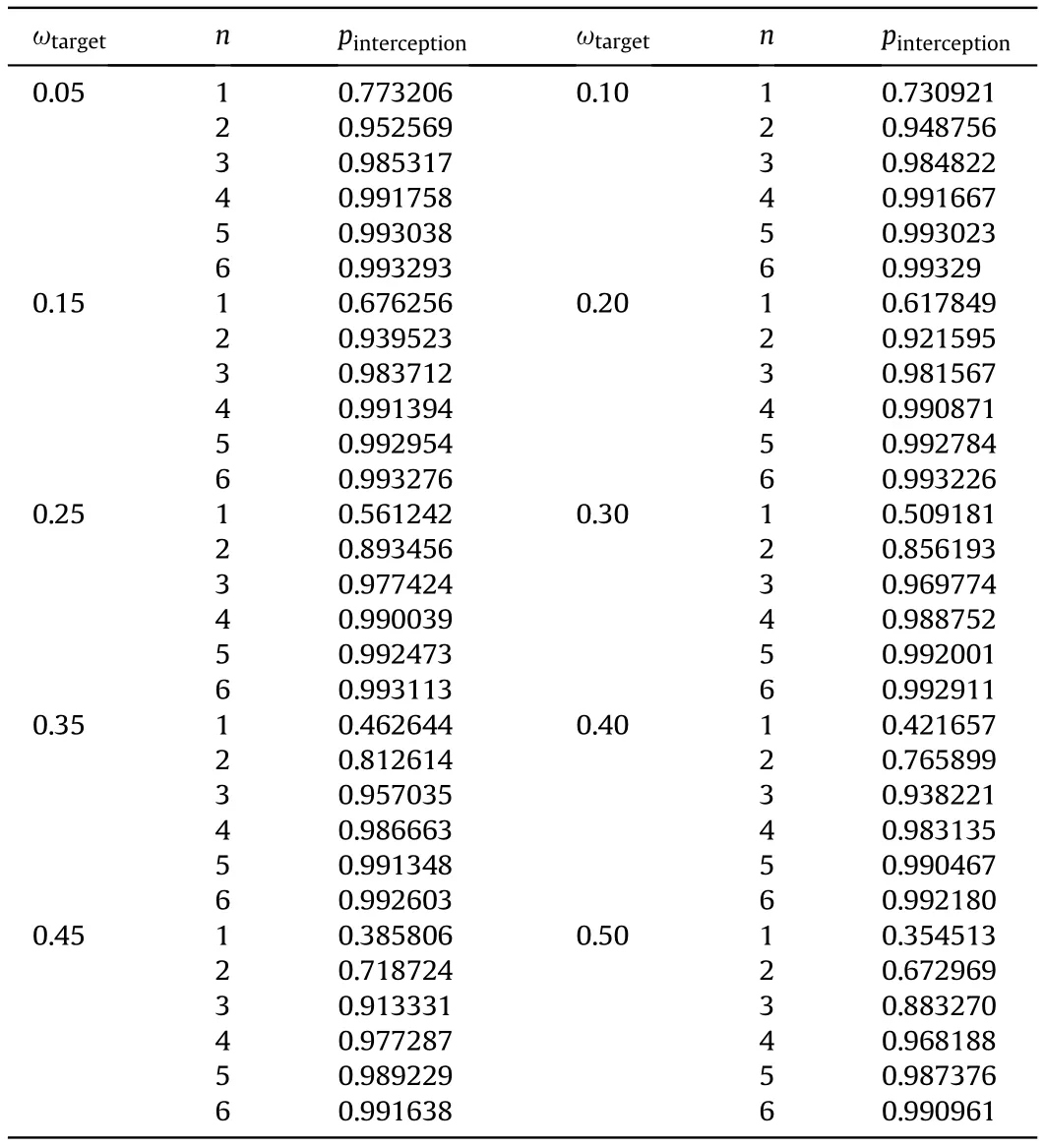
Table 3 Interception probabilities in different conditions.
Comparing strategies 1 and 2, the increase of the paralleled MGIWSs enhances the livelihood degree of the system, which indicates the effectiveness of the homogeneous parallel method to improve the livelihood degree.
Comparing strategies 2,3 and 5, it can be inferred that the increase of maintenance equipment can improve the livelihood degree, which implies that the method of adding livelihood maintenance agent can effectively adjust the livelihood degree of the system. Besides, according to strategy 5, the system will eventually fail without maintenance.
Strategy 4 represents the situation where all normal MGIWSs operate without considering the sleep strategy. Comparing strategies 2 and 4, it can be inferred that rational sleep strategy can improve the livelihood degree of the system, which verifies the availability of operational mode adjustment method.
Simulation 3. Consider the situation that there are I =6 strategic locations must be defensed by CIWSs. The maximum target intensity ω, the importance level g?{1,2,3}, the interception probability requirement W, and the livelihood degree requirement Dof each strategic location are shown in Table 5.
The costs of the operation of a MGIWS and a maintenance equipment are 1 per hour and 3 per hour, respectively.
To optimize the deployment and configuration strategy of the overall battlefield,the planning problem proposed in this paper can be adopted. The solution to the deployment and configuration problem can be represented by a chromosome X consists of 18 genes. The initial setting values of the parameters used in GA are:N= 200, N= 1000,P= 0.8, P= 0.01, P= 0.05, ε = 0.001.
Four solutions are given in Table 6.
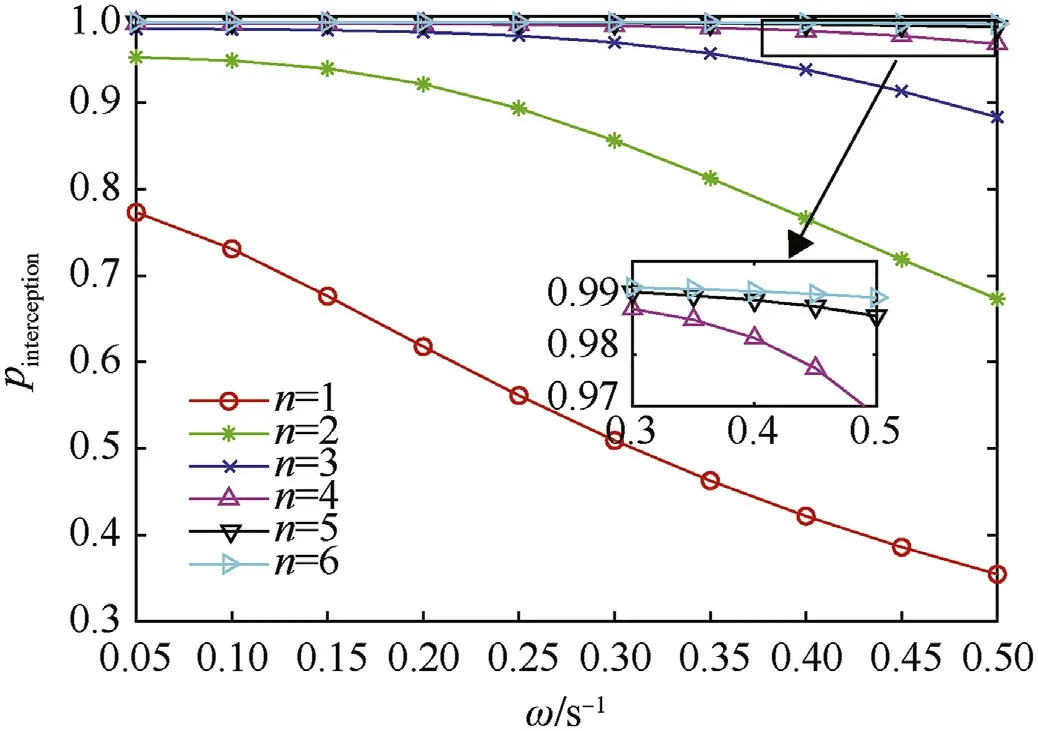
Fig. 8. Interception probabilities.

Table 4 Livelihood degree in different strategies.
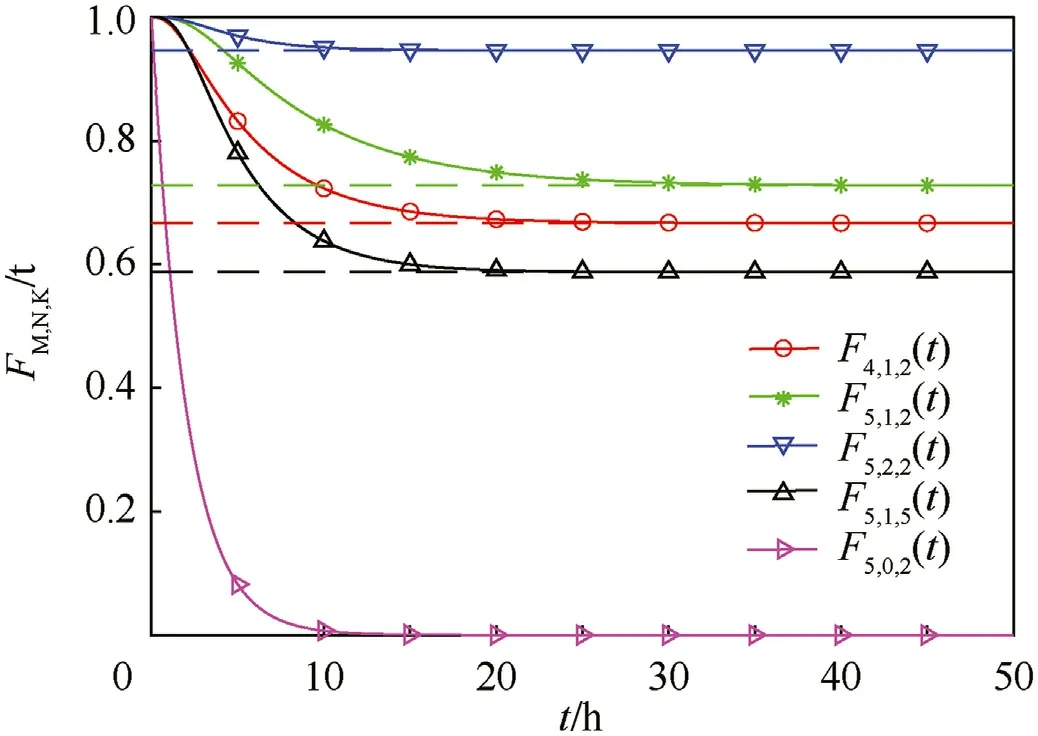
Fig. 9. Livelihood degree in different strategies.

Table 5 Parameters of different strategic locations.
The first solution is obtained via the proposed planning method based on the overall livelihood degree f, and the second one is obtained based on the overall CE f. For comparison, solution 3 is the configuration method that does not consider the sleep strategy on the basis of solution 1.Solution 4 is the solution to optimize the global ideal state performance, which can be expressed by the weighted arithmetic mean of the interception probabilities of multiple locations, that is,

where pis the performance when all the MGIWSs deployed at the strategic locations i are operating normally,which can be calculated via Eq.(5).At the same time,without considering the sleep strategy, making as many MGIWSs as possible work can make the system in the ideal state perform optimally. Then allocating the maintenance equipment according to the number of MGIWSs at each location, solution 4 can be obtained.
As shown in Fig. 10, the comparison of the overall livelihood degree,the overall cost,the overall CE,the number of locations that satisfied the livelihood degree requirements, and the ideal performance are presented.
Comparing solution 1 and solution 2,it can be inferred that the overall livelihood of solution 1 is higher than that of solution 2.However, due to the higher operating cost, its CE is lower. These two solutions match their optimization objectives, respectively.Because the planning processes of the two strategies are carried out under the constraints of livelihood degree, their deployment and configuration strategies at all the 6 strategic locations can meet the long-term combat requirements.
Compared with soulution1, solution 3 does not consider the sleep strategy proposed in this paper. It can be concluded that the operating cost of solution 1 is much lower than that of solution 3,and the livelihood degree is higher;whereas,its initial performance is lower than that of solution 3. Through the sleep strategy proposed in this paper, solution 1 keeps working with the minimum MGIWSs while satisfying the interception requirements, which reduces the operating cost of MGIWSs. Besides, the sleep strategy also reduces the maintenance pressure of maintenance equipment,which enables deteriorated MGIWS to be repaired in time. Due to the high operating intensity of solution 3, there are only two strategic locations that can meet the long-term operational requirements.
Comparing solution 1 and solution 4,the difference between the proposed method and the traditional performance-oriented method can be concluded. Solution 4 can achieve optimal performance when the system is in perfect condition,while solution 1 can ensure optimal combat effectiveness when the system is in longterm operation. In long-term operations, only 2 of the 6 strategic locations of solution 4 can meet the long-term operational requirements.
To analyze the computational effectiveness of the proposed method, mean square error (MSE) [41] is obtained through N=1000 independent GA optimization iterations. MSE can be calculated as

where Xis the ideal solution, Xis the best solution of the g-th generation in the k-th iteration. Using GA to optimize the deployment and configuration strategy X with the global livelihood fas the objective. Solution 1 in Table 6 is the optimal solution X. The curve of MSE with the change of generation is shown in Fig.11.TheMSE of proposed method gradually converges to a low level with the increase of generation.

Table 6 Solutions and performance of different strategies.

Fig.10. Comparison of parameters of different strategies.
Based on the above results, we can conclude that the proposed planning method can effectively optimize the deployment and configuration strategy of the equipment on the battlefield according to the long-term combat requirements.
6. Conclusion
In this paper, we propose a unified quantitative framework for the livelihood degree of the MLA system theory and the basic modes of livelihood adjustment. Based on the MLA theory, the effectiveness evaluation of CIWS and the optimization of battlefield equipment deployment and configuration strategies are carried out. This paper adopts a two-layer queuing model to evaluate the interception probability of MGIWSs in the joint operation.Considering the equipment failure and maintenance,the long-term combat effectiveness of CIWS under different configurations is evaluated with the livelihood degree.For the planning problem of equipment deployment and configuration on the battlefield, we propose two optimization objectives as overall livelihood and CE.Moreover,the optimization method based on GA is investigated to solve this planning problem.Finally,simulations are carried out to demonstrate the effectiveness of the proposed methods.
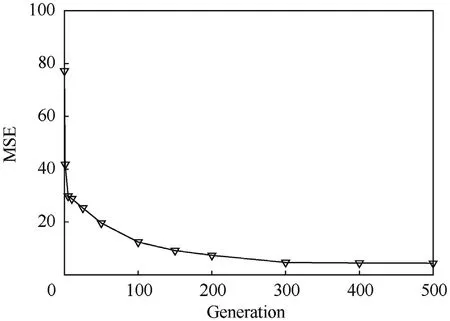
Fig.11. MSE with the change of generation.
On the basis of this article,there are some further studies can be done.In this paper,the interception probability is analyzed with the queueing model,and the service rate of the firing agent is obtained via the diversion fire time,which is the total time of the process.To consider the details of the process for more detailed evaluation,the method of modeling and simulation can be adopted. In the investigation of livelihood degree,the binary-state as normal and failure of the MGIWS is considered.In future work,the multi-state,such as the gradual degradation of equipment, can be studied to describe the transition of system states in more detail. Besides, this article mainly considers the deployment and configuration of equipment through prior information. In combat, the adjustment strategies based on the real-time changes of the situation should be further studied on the basis. Some parameters in this article are obtained through theoretical analysis, such as the theoretical searching probability of the paralleled radars,etc.In practical situations,these parameters should be analyzed in detail based on specific equipment and application environments.
The authors declare that they have no known competing financial interests or personal relationships that could have appeared to influence the work reported in this paper.
We would like to express our sincere thanks to the editors and reviewers for their constructive comments and suggestions which improved and enriched the presentation of the paper. Further, we are grateful to the experts who offered help to us.
This work is supported by the Beijing Natural Science Foundation under contract number L191004 and the National Natural Science Foundation of China under contract number U1833203.
- Defence Technology的其它文章
- A new model for the expansion tube considering the stress coupling:Theory, experiments and simulations
- Experimental and analytical assessment of the hypervelocity impact damage of GLAss fiber REinforced aluminum
- Effect of the microporous structure of ammonium perchlorate on thermal behaviour and combustion characteristics
- Modeling of bistatic scattering from an underwater non-penetrable target using a Kirchhoff approximation method
- 3,6-bis (2,2,2-trinitroethylnitramino)-1,2,4,5-tetrazine. Structure and energy abilities as a component of solid composite propellants
- Rapid preparation of size-tunable nano-TATB by microfluidics

